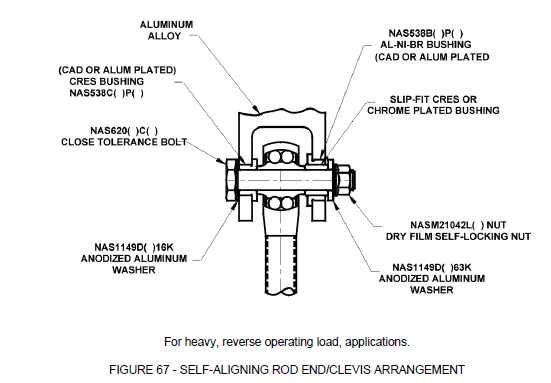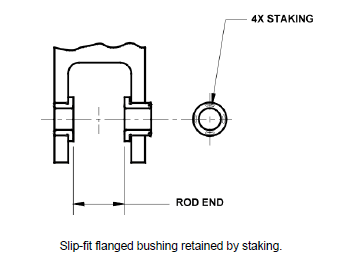For grins... Some ancillary documents [not mentioned in ARP5770] worth a look...
SAE
AIR1594 Plain Bearing Selection for Landing Gear Applications
AIR4094 Aircraft Flight Control Systems Descriptions
AIR5875 Methodology for Investigation of Flight Control System Anomalies
MIL-HDBK-1599 + N1 Bearings, Control System Components, and Associated Hardware Used In the Design and Construction of Aerospace Mechanical Systems and Subsystems
NOTE. I am not wild about the double bushing [plain bearing] system shown in tbuelna’s last post. The concept of having asymmetrical holes [two different sizes] in a symmetrical dual lug system tends to create a design/stress/maintenance asymmetry in the lugs at the holes. From my experience, this is NOT elegant/simplistic/durable/repairable as it looks.
NOTE. Any time a lug/clevis system is assembled like this, without means/methods to shim the single clevis lug to the center of the double clevis lugs, there will be a load eccentricity in the double clevis system... even a few thousandths of an inch toward one lug has a noticeable added/subtracted load affect; and in a highly loaded structure can induce significant secondary loading/bending that has to be accounted for.
NOTE. Chrome-plate bolts [shanks only] are often used in these type joints where 'bolt/pin shank-wear' is a potential issue within the bore of a hardened steel bearing inner-race.... leading to looseness.
NOTE. MANY years ago [1980], a friend who had worked for Boeing thru the 1960s into the early 1970s] ... and was ‘pink-slipped’ along with hundreds more engineers en-mass... walked-out with his mini design manual. He gave me his mini-BDM to photocopy ~1979. Best gift I ever received... It was loaded with structural and mechanical design insights, tips, lessons-learned, examples and general knowledge that kick-started my life my life-long quest/thirst for knowledge.
Regards, Wil Taylor
o Trust - But Verify!
o We believe to be true what we prefer to be true. [Unknown]
o For those who believe, no proof is required; for those who cannot believe, no proof is possible. [variation,Stuart Chase]
o Unfortunately, in science what You 'believe' is irrelevant. ["Orion", Homebuiltairplanes.com forum]



![[wink] [wink] [wink]](/data/assets/smilies/wink.gif)